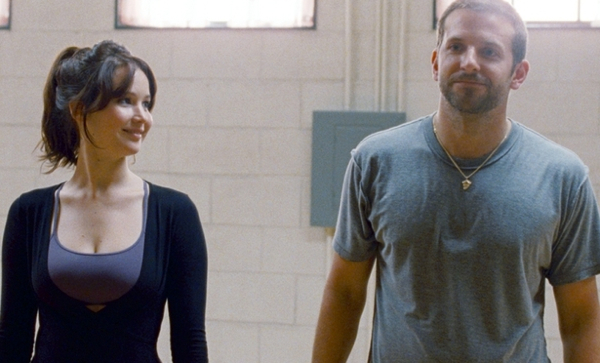Movie review by Greg Carlson
One of the questions nagging David O. Russell’s “Silver Linings Playbook” as it divides critical opinion like so many of the filmmaker’s previous movies asks whether his adaptation of Matthew Quick’s 2008 novel wallows in the feel-good, romantic movie clichés Russell once (seemingly) rejected. Has Russell, following seven Oscar nominations and a pair of acting wins for “The Fighter,” acquiesced to the corporate conventions demanded of so many Hollywood hit machines? Is filmmaking somehow less “personal” if the story involves impossibly attractive stars playing characters “struggling” with mental illness?
Some answers might be found in the pages of Quick’s often funny book, one of those buzzed-about debuts optioned for cinema prior to its publication. In an interview with Mike Ryan, Russell describes receiving the novel from Sydney Pollack as a project that was to have been made prior to “The Fighter.” The filmmaker worked through multiple drafts of the script, significantly altering story elements, dropping several subplots, reimagining characters, and perhaps most notably overhauling Pat Sr., a figure whose presence in the novel is as cold and authoritative as Robert De Niro’s performance is tender and fluid.
The principal romantic relationship, between Bradley Cooper’s bi-polar Pat and Jennifer Lawrence’s grieving Tiffany, makes the transition from the page largely intact, and Russell doesn’t blink at the obvious genre requirement demanding the final reel union of the pharmaceutical-dependent pair (it wasn’t a problem for Howard Hawks, Preston Sturges, or Gregory La Cava either). Ostensibly, Pat is wholly committed to reconciliation with his estranged wife Nikki, whose adultery triggered the physical outburst that landed Pat in an institution and now places a restraining order between them, but from the moment Tiffany shows up, Pat will be the only one convinced he still has any hope of restoring his old life.
Like nearly any classic screwball comedy, Pat’s relationship with Tiffany is predicated on the unlikely: because she has the necessary access, she will deliver Pat’s letters to Nikki as long as Pat agrees to dance with Tiffany in a competition. Quick’s novel arguably makes better use of such a harebrained premise, but Russell apparently sees less value in the mechanics of plot when opportunities for charged dialogue and physical closeness are so ripe. Quick is specific about the music that so deeply affects Pat, but the movie makes use of different selections. One look at the delightfully amateurish medley mashup choreographed by Tiffany for the dance finale explains why: Russell aches for the unexpected shifts in tone that might otherwise threaten the consistency of a less interesting world.
“Silver Linings Playbook” reiterates the director’s strengths, from his confidence with noisy ensembles to his appreciation for unfiltered, truth-hurts declarations. Russell’s respect for the messy, impolite exchange has manifested in some of the director’s greatest moments (often around dinner tables, as “Flirting with Disaster” and “I Heart Huckabees” attest). “Silver Linings Playbook” starts as a story about a delusional young man but by the time the title reaches fruition, it might have transformed into a story about a young woman just as determined to find her own redemption from the past.
